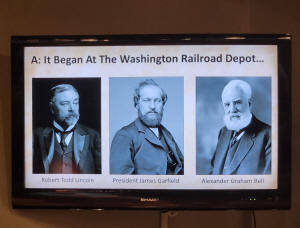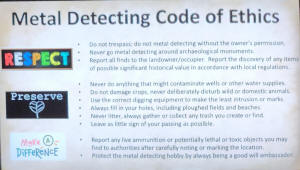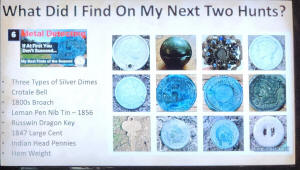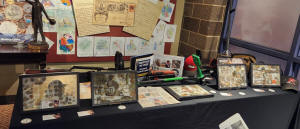|

Lincoln Heritage Museum Curator and Director Ron
Keller introduced Rizzo, who he called a passionate historian, metal
detectorist and storyteller.
For over 30 years, Rizzo helped Fortune 500 companies leverage
future technologies. Now, Keller said Rizzo searches for yesterday’s
lost artifacts and the stories they reveal about our collective
past.
As Keller said, Rizzo’s dedication to uncovering “rusty treasures”
has made him a compelling figure in the circles of historical
exploration and metal detecting. In interviews, Rizzo has said
“recovering old items and preserving their stories for others to
enjoy is what makes metal detecting so special.”

Keller asked everyone to join him in welcoming Rob
Rizzo as Rizzo shared “The History Beneath our Feet.”
Rizzo’s presentation focused primarily on why we metal detect,
Lincoln’s connection to metal detecting and metal detecting ethics
and equipment. He also discussed common questions asked of
detectorists, some of the history beneath our feet and Lincoln
related items.

Known as the “History Digger,” Rizzo has made YouTube
videos about some of his experiences. His presentation began with a
video showing some of his finds, which included rings, arrowheads,
coins and bullets.
For Rizzo, recovering old items makes metal detecting special. These
items tell stories of history beneath our feet. Rizzo loves history
and loves talking about various finds and treasures.
Rizzo’s nine-year-old son Axel, who functioned as Rizzo’s assistant,
has already found treasures of his own through metal detecting.
Axel’s first find was a silver ring on a chain.
When Rizzo asked people to guess why he does metal detecting,
guesses included liking it, being curious, not knowing what you will
find, the thrill of discovery, having adventures and saving history.
Rizzo said all those answers were correct.
Many people ask whether metal detecting can make you rich. A meme
Rizzo showed has a boy asking his dad whether metal detecting can
make you a millionaire. The dad’s answer is “yes it can, son, if you
start out as a billionaire.”
One reason Rizzo does metal detecting is that is it about unlocking
the stories [about items] and the part they play in history.
When Rizzo found a silver coin with a hole drilled in it, he did
some research and asked friends in the metal detecting community
about the reason the coin had a hole in it. He got answers like
being used for jewelry, as a medallion, as a button. Coins were also
sometimes smuggled by people on ships.

Bells are something else Rizzo has found and
researched. He said bells were a sign of prosperity when people had
a lot of bells on their carriage.
As people were travelling by carriage, Rizzo said if they came
across a fellow traveler in distress, they provided help to the
traveler in distress. People would give bells as a thank you to
someone who helped them out when they had trouble. The phrase “I’ll
be there with bells on” seemingly originates from this era. Arriving
at a destination without the bells hurt a driver’s professional
pride, whereas getting there “with bells on” was a source of
satisfaction.
Being a history buff, unlocking stories is something Rizzo enjoys.
Rizzo said, “metal detecting is the closest thing to time travel
that one can experience. It connects the past to the present and
helps preserve artifacts and their associated stories for years to
come.”

Metal detecting has an interesting connection to
Abraham Lincoln, too. To understand the connection, Rizzo asked
everyone to do a little time traveling with him by going back to the
Washington Potomac Railroad Depot where the lives of three men
interestingly intersected on one fateful day in July 1881. These men
were Robert Todd Lincoln, President James Garfield and Alexander
Graham Bell.
On July 2, 1881, two shots were fired by Charles Guiteau, a
disgruntled civil servant who had expected to get a coveted position
in President James A. Garfield’s administration. When Guiteau did
not get the position, he decided to take fate into his own hands.
At the Baltimore and Potomac Railroad Station in Washington, D.C,
Guiteau fired two shots at President Garfield. One bullet grazed
President Garfield’s top right shoulder. The second bullet entered
his chest.
Also present that day was Robert Todd Lincoln, the only one of
Abraham Lincoln and Mary Todd Lincoln’s son who survived to
adulthood. Robert Todd Lincoln had been appointed Garfield’s
Secretary of War.

The wounds President Garfield got from the shot were
not immediately fatal. Rizzo said he survived for two months.
One of the first physicians to attend to President Garfield was Dr.
Bliss. Rizzo said back then it was common practice to find a bullet
by probing a finger into the wound. If that did not work, a metal
probe would be used to try and locate the bullet.
Though Dr. Bliss tried these methods multiple times, Rizzo said he
was unable to find the bullet. As Rizzo pointed out, doctors did not
necessarily wash their hands before the procedure.
While President Garfield laid sick in the hospital, daily reports
went out about his condition.
Alexander Graham Bell heard about the president’s condition and
thought he could help using an electromagnetic device/ metal
detector. Rizzo said Bell was the inventor of the metal detector and
the first one to use it. Bell thought this device could locate the
bullet. Bell told Bliss about the device, but Bliss thought the
device was “quackery” and initially refused to allow Bell to use it.
Though Dr. Bliss did not think the device would work, he eventually
allowed Bell to test the device. The first time Bell used the
device, it detected the bedsprings. The next time, Dr. Bliss told
Bell where he thought the bullet would be found, but Bell was unable
to locate the bullet. Rizzo said Bell’s name for the first metal
detector was “the induction balance.”
Unfortunately, President Garfield died within a couple of months of
being shot. Rizzo said when an autopsy was done, the bullet was
found on the opposite side of where it had entered. Many believe the
device would have found the bullet [if Bell had been looking on that
side].
As for Robert Todd Lincoln, Rizzo said he is almost more fascinating
than his father. Some people refer to Robert Todd Lincoln as a
reluctant witness to history. For example, besides being President
Garfield’s Secretary of War, Robert Todd Lincoln had served as
Captain on General Ulysses S. Grant’s staff, was present at
Appomattox when General Lee surrendered and served as an ambassador
to Great Britian. Robert Todd Lincoln was also present at President
McKinley’s assassination. Along with several dignitaries, Robert
Todd Lincoln attended the dedication of the Lincoln Memorial in his
later years.
In another instance, Rizzo said Robert Todd Lincoln was standing on
a train platform and leaning against a stationary railcar. When the
car moved, Lincoln nearly fell onto the platform some distance down.
In an interesting twist of fate, Robert Todd Lincoln was pulled back
onto the platform by Edwin Booth, whose brother John Wilkes Booth
had assassinated Abraham Lincoln. Robert Todd Lincoln verified the
story of Edwin Booth saving his life.

Next, Rizzo talked about metal detecting ethics and
equipment. The code of ethics can be summed up as respect, preserve
and make a difference.
Under respect are three basic guidelines:
1. Do not trespass or do metal detecting with the owner’s
permission.
2. Never go metal detecting around archaeological monuments.
3. Report all finds to the landowners/occupier. Report the discovery
of any items of possible significant historical value in accordance
with local regulations.
[to top of second column] |

Preserving relates to the care of the land you do
metal detecting on. This list includes never doing anything that
might contaminate wells or other water supplies, not damaging crops
and not deliberately disturbing wild or domestic animals. It also
means using the correct digging equipment to make the least
intrusion or marks, always filling in holes, not littering,
gathering trash you create or find and leaving as little sign of
your passing through as possible.
To make a difference, you need to report any live ammunition or
potentially lethal or toxic objects you may find to authorities
after carefully noting or marking the location. It also means
protecting the metal detecting hobby by being a good will
ambassador. Rizzo said talking about the topic is part of making a
difference.

The metal detecting equipment Rizzo showed everyone
including a metal detector, pinpointer, hand tool, shovel and finds
pouch. Gloves are a good idea because Rizzo said people sometime
find sharp objects.
Cost wise, Rizzo said you can find good detectors for
in the $200 range. Technology has raised the price of metal
detectors. Rizzo said it is best to buy them from dealers because
the dealers can answer questions. There are many different companies
who sell the equipment. Rizzo and others have spent thousands of
dollars on equipment.

Rizzo shared a list of a metal detector’s favorite
questions:
• Looking for treasure?
• Find anything good yet?
• Find any gold?
• What’s the best thing you have ever found?
These are all questions Rizzo has heard many times.
When people do metal detecting in the United Kingdom, Rizzo said
they have to turn in their finds to Liaison Finds Officer. The
National British Museum has the right to claim the treasure and
purchase it on behalf on the museum. If the find is disclaimed,
Rizzo said the person who found it can take it home.
On a recent road trip, Rizzo and friends went to Manassas, Virginia
because they had heard union soldiers had had an encampment there.
Among their finds in Manassas were artifacts related to Union
Soldiers, a thimble, medallion, button and a cleaner bullet.
With the rifles soldiers used during the Civil War, Rizzo said
gunpowder would accumulate in the rifle, which made it hard to put
more bullets in the gun. The “cleaner bullets” reduced the
accumulation of gunpowder in the barrel. Rizzo said there was a
misconception that these bullets cleaned the rifles.
The Lincoln Highway is another area Rizzo has traveled. He said the
Lincoln Highway is the first coast to coast road in memory of
Abraham Lincoln. Rizzo traveled that road when heading to Goshen,
Indiana, where he found an old button from Maine. Uncovering the
story of the Lincoln Highway, which Rizzo said is like Route 66
stories, was the real treasure for Rizzo.
In New Bern, North Carolina Rizzo learned there may have been a
World War II Prisoner of War camp where Germans had been captured.
He found a block from the POW camp and gave it to New Bern’s
Historical Society.
An artifact Rizzo recovered in New Bern was connected to the town’s
first sidewalk. Rizzo said the State of North Carolina sued the
company that made the concrete because the concrete crumbled very
quickly. It was the first case that went to the State’s Supreme
Court.

As for a much wider span of history, Rizzo said he
has found several medieval coins. Rizzo’s friend Tim Blank, who was
at the presentation, once found a coin dating back to 70 B.C.
Another of Rizzo’s finds was a medieval train token. He has learned
not to throw anything away from a find. For instance, Rizzo nearly
threw away what he thought was a rusty nail. The “nail” turned out
to be a Roman Fibula, which was a pin that connected their cloaks.
What seemed to be a rusty penny was a second century Roman Bronze
coin.
At the Laura Ingalls Wilder homestead in Peppin, Wisconsin, Rizzo
found various artifacts related to stories from her books. He
donated all the items he found to the homestead’s museum.

With metal detecting, Rizzo said a lot of patience is
required. On Rizzo’s first time metal detecting in his hometown of
Oconomowoc, Wisconsin, he did not find anything. On Rizzo’s next two
hunts there, he found three types of silver dimes, a crotale ball,
an 1800s broach, an 1856 Leman Pen nib tin, a Russwin Dragon Key, an
1847 large cent, Indian Head pennies and a hem weight. He has
learned persistence is important.
A button from a boy’s school was one of the interesting finds there
for Rizzo.
In Oconomowoc, there was an old home known as Mon Bijou that was
originally owned by Peter Schuttler of Chicago’s Schuttler Wagon
Company. Rizzo got permission from the current owners to search the
property, which is now a bed and breakfast. After a few days of
searching and almost giving up, Rizzo found a 19th century watch
fob. He gave the watch fob to the inn’s owners.

Rizzo next showed a photo of several Lincoln related
finds friends of his have found such as a ribbon fob representing
the first crossing of the Mississippi River. The fob has Abraham
Lincoln and trains on both sides. Others have found campaign tokens
or belt buckles from organizations Lincoln established.
Audience members then had a chance to participate in some metal
detecting. Axel Rizzo handed out envelopes with various items to
several people. Rob Rizzo waved his metal detector over each
envelope and tried to guess what was in it. Items in the envelopes
included a Buffalo nickel, an Indian Head Penny, a button, silver
Liberty dime and a matchbox car. Rizzo correctly guessed some, but
not all of the items.

Towards the end, Rizzo asked if anyone had questions.
One person asked how you decide who keeps what.
Rizzo said when doing metal detecting, you are welcome to keep what
you find, but can also share the find with the property owner. It is
best to establish the expectations with the property owners. He said
signing a liability waiver is also wise.
Another question was about weather effects and moisture on finds.
Moisture may degrade metal items. However, Rizzo said some of his
best detecting has been on days after heavy rains.
When Rizzo was asked how deep he usually has to dig, Rizzo asked his
friend and fellow detectorist Jim Winter to provide an answer.
Winter said his metal detector can go about one foot into the ground
and it is pretty precise. He can dig a four inch wide plug in the
ground to get his target.
With the depth, Rizzo said it can depend on the size of the target.
Bigger items can be detected more deeply. When Rizzo flips over the
plug and finds coins on top, he gets excited.
There was a question about whether metal detectors can detect
pottery.
Though metal detectors can only detect metal, Rizzo said sometime
hot rocks, meteorites or coal will set off the detector. He will
find non-metal items like marbles when he digs the holes.

Once Rizzo finished his presentation, he invited
people to come to talk to him or look at some of the items he had on
display.
For more information, find Rizzo on his YouTube channel, The History
Digger. You can also find him on Facebook and Instagram under the
History Digger name.
[Angela Reiners] |